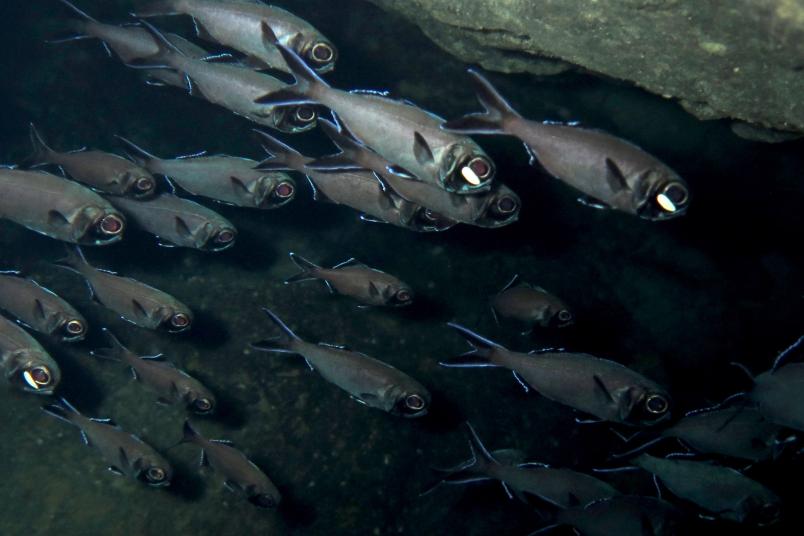
Biology
Light receptors determine the behaviour of flashlight fish
Bioluminescence is a phenomenon especially in marine environments. However, how it affects animal behaviour is difficult to analyse and to predict. A new study is shedding light on this phenomenon.
Biologists at the Ruhr-Universität Bochum characterized new, unknown photoreceptors from the bioluminescent flashlight fish Anomalops katoptron. The photoreceptors known as opsins allow the fish to detect light with a specific wavelength. As published on the 11th July 2018 in Plos One the scientists found new opsin variants, which are specialized to detect low intensity blue light in the wavelength range of bioluminescent light emitted by the fish. The blue light can be used to influence the fish behaviour.
The authors conclude that this specific blue light receptors and light processing is an evolutionary adaptation to the ecological environment of the fish. The study is an interdisciplinary biological approach combining the expertise of geneticist Dr Minou Nowrousian and Prof Dr Ulrich Kück, molecular biologist Dr Melanie Mark, zoologists Dr Jens Hellinger and Dr Marcel Donner as well as physiologist and optogeneticist Prof Dr Stefan Herlitze.
Two opsin variants to detect blue light
Besides the fact that bioluminescence is a widespread phenomenon in marine environments it is currently not known, how bioluminescence is processed and which physiological and behavioural consequences bioluminescence is evoking in most species. The flashlight fish Anomalops katoptron can be seen in shallow waters of coral reeves at moonless nights and is found during the day in caves up to 400 metres deep. Light organs are situated under the eye, which produce blue light with a wavelength of 490 nanometres, which is used to detect and hunt prey.
The research team analysed the photoreceptor composition of the retina and found two visual pigments, which resemble the visual pigments expressed in the mammalian retina. Both of these photoreceptors are activated by low intensity blue light in the range of 490 nanometres, which match the wavelength range of its own bioluminescent light.
Fish are conditioned during feeding
Next, the research team analysed if Anomalops katoptron uses blue light for behavioural responses. They performed a Pavlovian conditioning task with eight fish, where the fish had to associate feeding with a specific light pulse. “The fish were fed in darkness, but we used a strong red flashlight to illuminate the feeding area. We thought originally that the fish cannot see the red light,” says Jens Hellinger, “but found that they can associate the red light with food. Thus, once we switched on the red light at the corner of the aquarium, the fish swam into the light beam”.
The scientists used this phenomenon to perform a behavioural test, to show that flashlight fish would react only to specific wavelength of light. They used a much lower light intensity in comparison to the red flashlight and found that the fish now only reacted to low intensity blue but not red light.
Adaptation to star light and bioluminescence
“The visual system of flashlight fish seems to be adapted to detect low intensity light, such as star light or bioluminescent light to adjust their own behaviour”, concluded Stefan Herlitze. The low light detection reveals a new behavioural function of bioluminescence in fish.
Bioluminescence
Bioluminescence involves a chemical process where free energy is converted into light. The phenomenon is found in various different species from bacteria, fungi and insects to vertebrates. Bioluminescent light is often produced in specialized cell organelles or light organs. Light organs filled with symbiotic bacteria are for example often found in deep-sea fish to produce behaviour-relevant light signals.